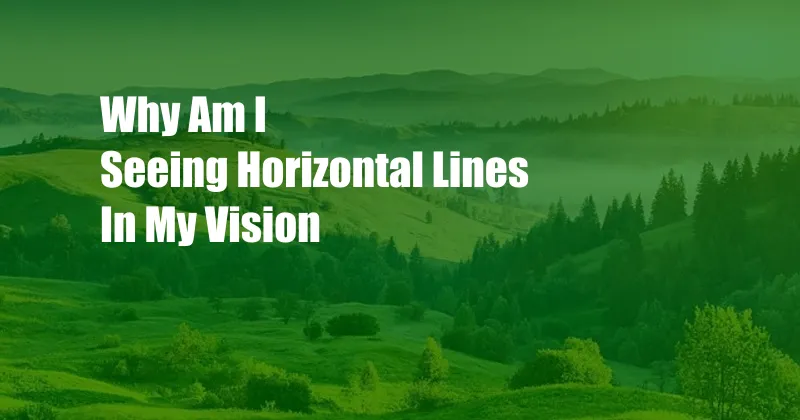
Why Am I Seeing Horizontal Lines in My Vision?
Have you ever looked up at the sky on a bright day and noticed squiggly lines dancing across your vision? Or perhaps you’ve seen horizontal bars or shimmering waves disrupting your focus while staring at a computer screen or reading a book? These visual disturbances, commonly known as visual snow, can be puzzling and even alarming.
Visual snow is a relatively common condition characterized by the persistent perception of tiny, flickering dots or lines in one’s field of vision. While it can be distracting or disconcerting, it’s important to know that visual snow is typically benign and does not pose a significant health risk.
Causes of Visual Snow
The exact cause of visual snow is still not fully understood. However, it’s believed to be related to abnormal activity in the visual cortex, the part of the brain responsible for processing visual information. Some potential triggers include:
- Head trauma
- Eye strain
- Certain medications
- Migraines
- Alcohol or drug use
Pathophysiology of Visual Snow
Visual snow is thought to arise from hyperactivity in the visual cortex, specifically in the primary visual cortex (V1) and the extrastriate visual areas (V2, V3, V4, and V5). This hyperactivity may be caused by a variety of factors, including:
- Abnormalities in neurotransmitter levels: Neurotransmitters are chemicals that allow nerve cells to communicate with each other. An imbalance in neurotransmitter levels, such as GABA and glutamate, can lead to altered visual processing and the perception of visual snow.
- Increased spontaneous neural activity: Even in the absence of visual input, neurons in the visual cortex can spontaneously fire, leading to the perception of visual snow.
- Structural abnormalities: Researchers have observed structural differences in the brain of individuals with visual snow, such as reduced cortical thickness and abnormal white matter integrity.
Symptoms of Visual Snow
The most common symptom of visual snow is the presence of tiny, flickering dots or lines in one’s field of vision. These dots or lines can vary in size, shape, and color, and they may be more noticeable in certain lighting conditions, such as bright sunlight or dim lighting.
Other symptoms of visual snow may include:
- Floaters (small, dark spots that move across the field of vision)
- Afterimages (images that persist after the source of light has been removed)
- Photophobia (sensitivity to light)
- Headaches
- Tinnitus (ringing or buzzing in the ears)
Treatment Options
There is currently no cure for visual snow. However, some treatments may help to reduce the symptoms:
- Avoiding triggers: Identifying and avoiding triggers, such as bright lights or certain medications, can help to reduce the severity of visual snow.
- Eye drops: Artificial tears or other eye drops can help to lubricate the eyes and reduce eye strain.
- Medications: Some medications, such as anti-seizure medications, have been shown to reduce the symptoms of visual snow in some patients.
Lifestyle Tips and Expert Advice
In addition to the above treatment options, there are a number of lifestyle tips and expert advice that may help to manage visual snow:
- Get regular eye exams: Having regular eye exams can help to rule out any underlying eye conditions that may be contributing to visual snow.
- Take breaks from screen time: Staring at screens for long periods of time can strain the eyes and worsen visual snow. Take regular breaks to rest your eyes and focus on something else.
- Exercise regularly: Exercise can help to improve circulation and reduce stress, which may have a positive impact on visual snow.
- Get enough sleep: Sleep is essential for overall health and well-being. Getting enough sleep can help to reduce stress and fatigue, which may improve visual snow symptoms.
FAQs About Visual Snow
Q: What causes visual snow?
A: The exact cause of visual snow is not fully understood, but it is believed to be related to abnormal activity in the visual cortex, the part of the brain responsible for processing visual information.
Q: Is visual snow a serious condition?
A: Visual snow is typically not a serious condition and does not pose a significant health risk. However, it can be a nuisance and may interfere with daily activities.
Q: Is there a cure for visual snow?
A: There is currently no cure for visual snow. However, some treatments may help to reduce the symptoms, such as avoiding triggers, using eye drops, or taking medications.
Conclusion
Visual snow is a common condition that can be frustrating and disruptive. While there is no cure, there are a number of treatment options and lifestyle tips that may help to reduce the symptoms. If you are experiencing visual snow, it is important to see an eye doctor to rule out any underlying eye conditions.
Would you like to know more about visual snow? Please leave a comment below, and we will be happy to answer your questions.